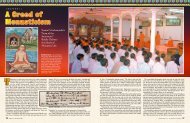Hinduism Today January 2009 - Cover, Index, Front Articles
Hinduism Today January 2009 - Cover, Index, Front Articles
Hinduism Today January 2009 - Cover, Index, Front Articles
Create successful ePaper yourself
Turn your PDF publications into a flip-book with our unique Google optimized e-Paper software.
photos: amit misrathe belief that they and their family will beprotected from eye ailments.Chintpurni DeviOur next destination, Chintpurni Devi, islocated in the district of Una, 100 kms fromNaina Devi. We arrived there at about 11in the morning and found a two-kilometerqueue leading to the temple. The shopkeepersinformed us that today, Sunday, was themost crowded. We waited stoically for ourturn, even as the kids refused to show anounce of patience. Punjabi devotees handingout toffees and chips in massive quantitiesprovided a welcome relief.Finally, our turn came, and we entered theshrine amidst much hustle and bustle. Thehuge crowd refused to remain orderly, despitethe efforts of police deployed for thatpurpose. Nobody was allowed to stay in theshrine for more than two seconds as thehordes of people pushed their way inside. Itwas only with some luck and skill that wewere able to have a proper, though fleeting,glimpse of the Deity. The Goddess here, too,resides as a pindi. This shrine has an extremelypowerful vibration. The priests saidit is a seat of tantra, a mystical and magicalform of worship.A large “wish-fulling” banyan tree in thetemple courtyard is festooned with thousandsof red threads. Devotees make a wishOn pilgrimage: (clockwise from above)The silver Sivalingam at Naina Devi; thewish-fulling tree at Chintpurni bedeckedwith thousands of red threads tied thereby worshippers; triplets Varun, Rimjhimand Aryan pose in front of the four lionvahanas at the Vaj reshwari Devi temple.and tie a thread on the tree as a symbol oftheir wish and faith.After our tumultuous ordeal to meet withthe Goddess, we spent some quiet time nearthe temple enjoying the delicious suji kahalwa, a semolina sweet, served as prasadamby the temple priests.Jwala DeviOur next stop was Jwala Devi, just 30 kilometersaway. The Goddess here manifestsin the form of fire or jwala, emanatingfrom a wall. Sati’s tongue is said to havefallen here. Dedicated to the nine GoddessesJwalamukhi, those of “flaming mouth,” thetemple has nine permanent flames namedafter the Goddesses—Mahakali, Unpurna,Chandi, Hinglaj, Bindhya Basni, Mahalakshmi,Saraswati, Ambika and Anji Devi. Allthese flames, or jyotis, have been burningincessantly since time immemorial. Thismiracle reminds us of the triviality of humanknowledge and existence before theinfinite and unfathomable powers of nature.According to our guide, several excavationsfor the source of fuel were unsuccessful.The main attractions of the temple arethe arati sessions—at early morning, sunrise,afternoon, evening and bedtime. A beautifulroom has been designed for the Goddessin the spacious temple premises where Shesleeps every night after the evening arati.The bed in this room is piled high with richdresses decorated with precious ornaments.After visiting the shrine, we went to thelangar, a free feeding place providing generousquantities of dal and rice. In addition tothe devotees, thousands of poor and hungrypeople are fed here daily.Vajreshwari DeviOur next destination was Vajreshwari Devi,after whom the district of Kangra has beennamed, about 20 km from Jwala Devi. Theoriginal shrine was destroyed by severalinvaders, beginning with Muhammad ofGhazni in the 11th century ce, but it hassince been restored to its original glory. Thistemple was uncrowded and well organized,without the hustle and bustle that hauntedus in the previous shrines, and we had a longand lingering meeting with the Goddess.In the market here are shops that sellbrass wares unique to Himachal Pradesh.We saw beautifully designed incense stickstands, faces of Gods and Goddesses, showpiecesand statues. We spent a small fortuneon these items before proceeding on!Asked about the origin of the 51 Peethas, most Hinduswould relate the story of Daksha’s yajna, or grand sacrifice,to which he invited all the Gods except Lord Siva. Accordingto the story, Sati, Siva’s wife and daughter of Daksha,appears uninvited at the sacrifice to confront her father anddemand an explanation for the insult to her husband. Humiliatedby his arrogant response, she jumps into the sacrificial fire anddies. Siva, learning of the tragedy, destroys the sacrifice, cuts offDaksha’s head, picks up the body ofSati and dances distraught across India.Lord Vishnu, fearing the consequencesof Siva’s grief, cuts Sati’s body intopieces with His discus. As each fallsto the ground, it creates one of the 51sacred Peethas, each associated with aspecific body part, from Sri Lanka tothe Himalayas.Seeking further explanation ofthis story, <strong>Hinduism</strong> <strong>Today</strong> queriedDr. S. P. Sabharathnam, one of India’sforemost scriptural experts. Hereplied that according to the basicShakti scriptures, such as TantrarajaTantra, Yogini Hrudayam and NityaShodasikharnava, there are indeed 51Shakti Peethas, one for each of the 51 letters of the Sanskrit alphabet.But he disputes their association with Daksha’s sacrifice andthe decimation of Sati’s body.Instead, he says the peethas are related to Shakta or Tantricworship rituals, specifically, the practice of nyasa. Accordingto the website, www.shivashakti.com, “The word nyasa means‘placing’ and refers to a large component of Tantric worship inChamunda DeviOur final destination was Chamunda Devi, ashrine equally important for Lord Siva. Accordingto our guide, this site was originallyonly for Lord Siva and called NandikeshwarDham. The Chamunda Devi shrine waslocated 16 kilometers away, on top of theDhauladhar Hills. This is the place whereGoddess Kali is said to have defeated the demonsChand and Mund—hence the shrine’sname, Chamunda. The Deity or pindi ofthe Goddess is said to have come down themountain in a flood and ever since has beenhoused in the current shrine along withNandikeshwar Mahadev. It is one of themost powerful and fierce incarnations ofthe Goddess.The system of queues was well managed,as in the Kangra Devi shrine. Every devoteehad an opportunity to have a proper view ofthe Deity. The pindi of the Goddess is not asabstract as in the previous shrines. The traditionis that this Deity is so powerful thatno one can gaze at it directly. Hence, it iskept completely draped in a red cloth.A novel aspect of the shrine is the Deityof Lord Nandikeshwar or the Sivalingamwhich is located below a huge boulder. ThisSivalingam was found existing here naturally.A tiny temple was built around it withoutdisturbing the actual setting. Only oneperson at a time can go inside. Despite theclaustrophobic space, the temple is full ofpositive vibrations. Ardent devotees of Sivaclaim that a distinct sense of presence of theAlmighty can be felt inside that sanctum.The area on the river near the shrine hasbeen beautifully developed as a theme parkThe Origins of Shakti’s 51 Power Centersdinodia aadDevi’s chambers: The shrine at JwalaDevi where the Goddess spends the nightJwala Devi: Gold-leafed dome of the fire templewhich the practitioner touches various parts of his body while atthe same time pronouncing a mantra and visualizing a devata (divinebeing) or a bija (root) mantra. Nyasa is intended to ‘divinize’the body of the worshipper.”Dr. Sabharathnam goes to explain, “At the beginning of the SriChakra or Sri Vidya worship, six nyasas are to be performed, ofwhich peetha nyasa is the sixth. During this nyasa, the priesttouches 51 parts of his body—head, face, right eye, left eye, andso on—while reciting a bija mantraand naming the location of one ShaktiPeetha—Kamarupa, Varanasi, Nepala, etc.According to Dr. Sabharathnam, thescriptures listing the peetha nyasa predateany association with the story ofDaksha’s sacrifice. He said, “In order tolink the peethas with the Puranas, thelater Puranic writers—that is, after the16th century—added the story of Sati’sdismemberment. The Skanda Mahapuranadeals at length with Daksha’syajna but makes no mention of Siva carryingoff Sati’s body, nor do any of theauthentic Shakta Tantras. The story is afabrication.”“These later writers,” he goes on, “tookthe existing peetha nyasa, in which each Peetha is identifiedwith a part of the worshiper’s body, and incorporated it into thestory of Daksha’s sacrifice. In the process, they created at leastseven different lists of the Peethas, including one of 108. Theselater writings do not tally with the correct list provided in YoginiHrudayam and other authentic Tantric texts. Such fabricated listshave been proliferating endlessly from the 17th century.”34 hinduism today january/february/march, <strong>2009</strong> january/february/march, <strong>2009</strong> hinduism today 35
















